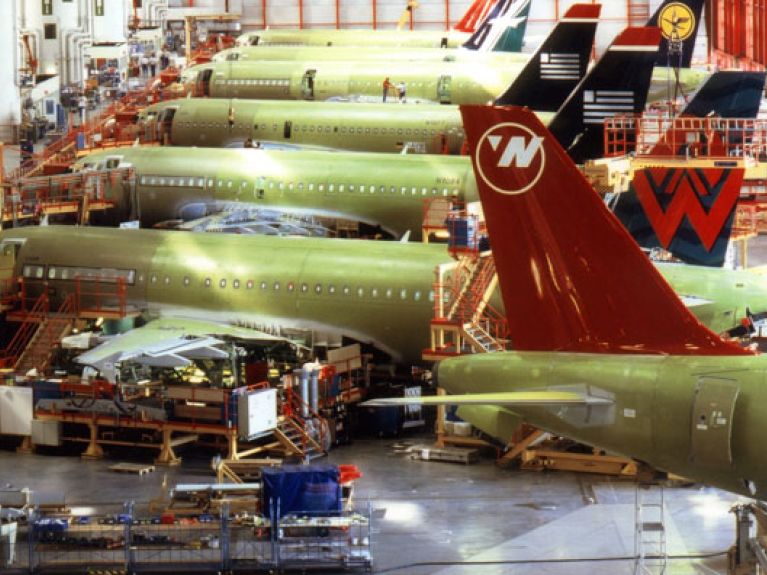Successful on the world market
Companies from the EU underline their competitiveness and thereby strengthen their economic position on world markets.

More than half a trillion euros. That is the value of the orders currently on the books of EADS, Europe’s largest aerospace group. If the orders stopped coming in tomorrow, the workers in its plants would still have work for the next eight years. The order books have doubled in size in five years.
This striking success story stands in stark contrast to general perceptions of the situation in Europe. Unemployment has increased by over 7% in the last four years and almost one in ten Europeans are jobless. And yet the EU is upholding its goal of again being counted among the world’s strongest economic regions by 2020. Economic growth is thus meant to rise to an average of 2% and the proportion of spending on research and development to 3% of gross domestic product. Impossible? Perhaps not all companies will survive the crisis and unemployment in Europe will initially continue to rise, but success can be achieved with the right recipe.
EADS’s exceptionally good order situation is also due to policy support. Last year, 144 aircraft were secured with export guarantees. So-called Hermes cover protects German businesses against non-payment for economic or political reasons, and in the case of the aircraft it is arranged in coordination with French and UK government export insurers. In some months, one third of the aircraft that take off for delivery to customers from Toulouse or Hamburg fly with government guarantees. The development of aircraft also involves government funding. When the new A350 jet is assembled for the first time in summer 2012, it will only have been possible because Germany and France supported the development with loans worth billions of euros. The history of the Airbus is therefore also one of successful regional economic policy. Today Airbus – and not its major US rival Boeing – is the market leader.
When Airbus aircraft fly around the world, almost every day their cargo holds carry shipments from Bosch, the automotive components supplier. Over 125 years after the precision engineering and electrical engineering workshop was set up in a Stuttgart courtyard, the German family business has nothing to fear from competitors. In 2011 the company achieved a record turnover of 51.4 billion euros. Bosch realizes three-quarters of its sales outside Germany, but four out of ten euros of its global added value is achieved on the home market. Supervisory Board Chairman Franz Fehrenbach considers this a law at Bosch: “We have continuous improvement in our genes.” That represents a huge understatement. The company spends billions to remain successful.
Hardly any other industrial enterprise in the world invests more of its revenues in research and development than the Stuttgart-based company – the most recent total was 4.1 billion euros or more than 8% of turnover. Its employees register an average of ten patents worldwide every day. For years now the German automotive component supplier with 300,000 employees has been considered a patent world champion. The secret of its success also lies in its corporate structure. The company is still not listed on the stock exchange. 92% of the limited company is owned by a foundation. The group is managed by a trust made up of former and active senior executives. They ensure that profits are mainly invested in the future of the business. In good years the group nevertheless distributes up to 180 million euros – among its employees.
The success of Swedish clothing manufacturer H&M is evident in every large pedestrian precinct. It is difficult to imagine that another European company surpasses the Scandinavians. However, Spaniard Amancio Ortega has succeeded in doing that so well that he is today not only the richest man in Spain, but also the fifth richest on the planet – according to Forbes, the US business magazine, his assets in 2011 amounted to 37.5 billion dollars. After beginning as an errand boy for a textiles seller, at the age of almost 40 he founded the clothing business that was later to make him rich – Zara. He later formed it into the Inditex group. No fashion chain has more branches worldwide today – and every day another shop is added. In 2011 there were a total of 5,500 shops, twice as many as the Swedish competition.
From the very beginning Ortega relied on copying the colours and trends of the big fashion shows and putting them into shops at affordable prices. The sewing workshops and design studios of Galicia have always remained the heart of the company. From there the goods can reach US and Chinese branches within 40 hours. The European market is more important, however. Normally, manufacturers wait weeks to import their products from India, China or Bangladesh, where Zara also produces merchandise.
However, the trends continue to be set at home – and arrive in European branches with lightning speed. “The disadvantage of higher wage costs is more than offset by the short distances and the highly skilled sewing workers and seamstresses in Galicia,” explains business consultant Roland Berger. As a result of a firm policy of globalization the group is now only 25% dependent on its home market. That enabled it to earn almost two billion euros in spite of the serious recession in Spain.
